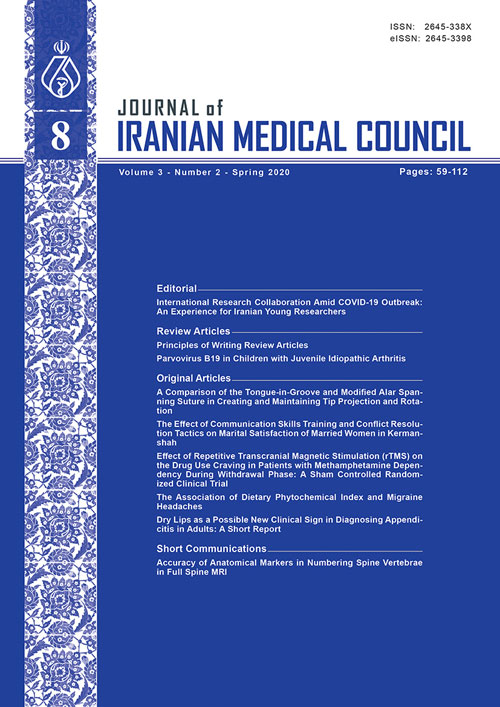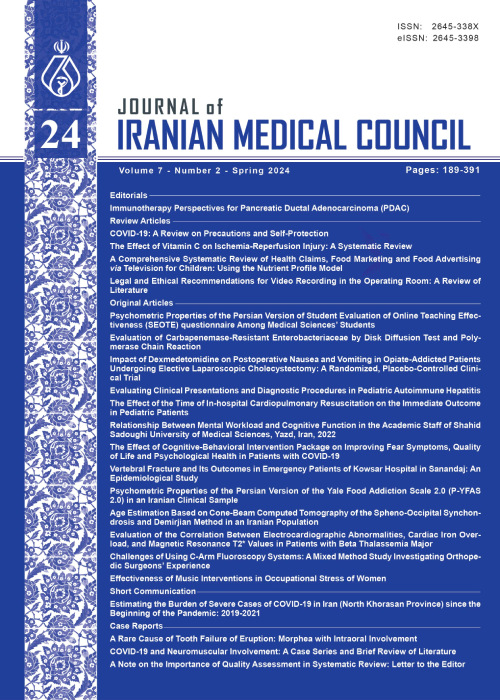فهرست مطالب

Journal of Iranian Medical Council
Volume:3 Issue: 2, Spring 2020
- تاریخ انتشار: 1399/06/01
- تعداد عناوین: 9
-
-
Pages 59-60
Early Career Psychiatrists (ECP) section of World Psychiatric Association (WPA) was officially launched in 2014, while this global organization had been developing the collaboration of ECPs in different activities, more specifically, by inviting several fellows to attend world congresses of psychiatry since 1999 (1).
Fortunately, I joined the section in the 17th World Congress of Psychiatry, where I could attend as one of the ECPs fellowship awardees in Berlin, Germany. After a while, the section provided collaborative platforms as Google and WhatsApp group which have been developed by participation of more young psychiatrists and psychiatric trainees all around the world for 3 years. It should be noted that social gathering of members during the last three annual World Congresses of Psychiatry which were held in Berlin, Lisbon and Mexico City have had a substantial role in developing relationships and collaborations. -
Pages 61-67Background
Review studies (Literature review) are instructive scholarly papers with low cost of preparation and acceptable novelty and they are considered interesting material for scientific journals. These articles summarize previously published studies and provide a critical and useful analysis of the current literature in a particular topic through summarizing, classification, and comparison of related research papers.
MethodsData from international databases including PubMed, Scopus, Google Scholar and Web of science were collected and evaluated.Results and
conclusionIn this paper, a brief glance and instruction about the organizational pattern of the text and appropriate writing methods in narrative review articles were provided for enthusiastic students who want to take steps in this field.
Keywords: Bibliometrics, Humans, Pubmed, publications, Research Design, Students, Writing -
Pages 68-72Background
The causal role of Parvovirus B19 (B19V) in Juvenile Idiopathic Arthritis (JIA) is still a matter of debate. In this study, an attempt was made to investigate the frequency of B19V infection and the association between patients’ characteristics and B19V infection in children with JIA.
MethodsSynovial fluid samples were obtained from 27 children (13 boys, 14 girls, aged 3-16 years) with JIA and were analyzed by polymerase chain reaction to detect B19V DNA. Age, sex, number of involved joints, time elapsed between beginning of symptoms and arthrocentesis, serum Erythrocyte Sedimentation Rate (ESR) and C-Reactive Protein (CRP) were compared between JIA patients with and without B19V.
ResultsSix patients (22.2%) were B19V+. There was no significant association between presence of B19V DNA in synovial fluid and number of joints involved, duration of disease, treatment with Disease-Modifying Anti rheumatic Drugs (DMARD) or glucocorticoid therapy and mean ESR and CRP levels. However, there was a slightly significant relationship between sex and age and detection of B19V DNA in the synovial fluid of JIA patients.
ConclusionOur study demonstrated a 22% prevalence of B19V infection in JIA patients, and also that there was a significant relationship between sex and age and detection of B19V DNA in the synovial fluid of JIA patients.
Keywords: Juvenile idiopathic arthritis, Parvovirus B19, Polymerase Chain Reaction -
Pages 73-78BackgroundThe tongue-in-groove technique and alar spanning suture are two popular rhinoplasty techniques for adjusting tip rotation and projection. Herein we compared the long-term results of these two techniques on tip projection and rotation.MethodsA prospective review was undertaken. 41 patients who had undergone rhinoplasty from 2016 to 2019 were included in this study. Among them, 26 patients had undergone tongue-in-groove technique as the main method to create ideal tip rotation and projection and an alar spanning suture, incorporating the dorsal septum, was used in remainder. Using pre and postoperative photographs, tip rotation and projection were evaluated and compared between two groups after one year.ResultsThe patients mean age was 31.4±7.6 years. Thirty-one (75.6%) of the patients were female. The mean follow up was 11±2.9 months. The tongue-in-groove technique group had significantly better tip rotation results (p value= 0.028), but there was not a significant difference in their projection.ConclusionAccording to our results, the tongue-in-groove technique is a more effective tool for creating of an ideal tip rotation when compared to reconstitution of tip support with an alar-spanning suture that incorporates the supratip septum.Keywords: Females, rhinoplasty, rotation, Sutures, Tongue Diseases
-
Pages 79-88Background
Communicating skills training is one of the most important ways to enhance the marital adjustment and satisfaction. The objective of the present study was to investigate the effect of communication skills training and conflict resolution tactics on marital satisfaction in married women in Kermanshah during the year 2017.
MethodsThe study was conducted as a trial with a control group among 134 married women referring to Kermanshah health centers. The inclusion criteria of the study included living with a spouse in the first five years of marriage and minimum reading and writing literacy. The research subjects were selected by convenience sampling method. Demographic questionnaire, Enrich Couple Inventory, and Revised Conflict Tactics Scale (CTS2) were completed by the subjects and a training workshop on beliefs and expectations from marital life and communication skills was provided for the intervention group. One month after the intervention, Enrich Couple Inventory and revised Conflict Tactics Scale were re-completed. Data were entered into IBMSPSS STATISTICS version 22 software and the effect of training intervention was investigated using Student T-Test and repeated measures.
ResultsBefore the intervention, two groups of the study did not show a significant difference in demographic characteristics, conflict resolution tactics and communication skills. One month after the intervention, the mean scores of sub-scales of negotiation, aggressor negotiation, and victim negotiation of CTS2 scale were significantly higher in the intervention group than those in the control group. Most of the CTS2 subscales in the intervention group and some subscales in the control group had significant changes. Comparison of changes in the scores did not show a significant difference between the two groups. In examining the trajectory of changes, both groups showed significant changes in most subscales of the CTS2; however, there was no significant difference between the two groups.
ConclusionIn general, modification of beliefs and expectations from marital life and teaching communication skills in the form of short-term intervention can be effective in improving the methods of resolving conflict between couples. Since marital satisfaction is a complex concept, achieving more accurate results in this area requires more extensive studies.
Keywords: female, Marriage, Negotiating, Personal satisfaction -
Pages 89-98Background
Methamphetamine is considered as one of the potent psychological stimuli with high addiction capacity. Drug craving is one of the most critical factors in drug addiction, leading to drug use relapse once withdrawn. The objective of the present research was to evaluate the effect of Transcranial Magnetic Stimulation (rTMS) on the drug craving in patients using methamphetamine.
MethodsThis study was conducted in a double-blind sham-controlled design on 31 patients in Summer 2016. The patients were randomly assigned into 3 groups (each group comprising10 subjects) and rTMS was performed at the left Dorsolateral Prefrontal Cortex (DLPFC) with frequency of 15Hz and the left Orbitofrontal Cortex (OFC) with a frequency of 1 Hz. One day before the onset of the intervention and one week following the completion of it, the subjects were evaluated using Hamilton Rating Scale for Depression (HRSD), The Brief Psychiatric Rating Scale (BPRS), and visual cue-induced craving assessment task. In a 6-month follow up after the completion of the sessions, the patients were asked whether they tended to be hospitalized (psychiatric service, campus) for psychiatry or substance was collected in a self and family report manner by phone call. Two patients in the DLPFC group, 1 in the OFPFC, and 4 patients in the control group were hospitalized. However, these frequencies were not statistically significant (p=0.343, χ2=2.139).
ResultsRepetitive magnetic stimulation failed to significantly reduce craving, but in a 6-month follow up, most cases of substance related hospitalization were reported to be in the control group.
ConclusionrTMS can reduce the complications of using methamphetamine, such as the number of substance related hospitalizations.
Keywords: Amphetamines, craving, Dorsolateral prefrontal cortex, Orbito frontal lobe, Transcranial Magnetic Stimulation -
Pages 99-105BackgroundMigraine is a neurological disorder which can threaten public health and cause socio-economic burdens. Dietary factors are proposed to be associated with migraine pain. The aim of this study was to examine the association between Dietary Phytochemical Index (DPI) and headache severity and duration among migraine patients.MethodsA sample of two hundred and sixty-six women (18-50 years) took part in the study. Dietary data was collected using a validated and reliable food-frequency questionnaire. DPI was estimated by a formula (Daily energy derived from phytochemical-rich foods (kcal)/total daily energy intake (kcal)×100), based on dietary intake. Anthropometric measurements, headache duration, and visual analog scale for pain questionnaire were assessed for all cases.ResultsAn inverse association was found between high-DPI score and severe headaches (OR=0.67; 95% CI: 0.61, 0.98; p=0.011). However, headache duration showed no significant association with DPI score (β= -0.10, 95% CI: -0.51, 0.27, p=0.25).ConclusionThe present study showed that adherence to phytochemical-rich diets may be associated with reduced headache in migraine patients.Keywords: Headache, Migraine disorders, Pain, phytochemicals, Visual Analog Scale
-
Pages 106-108BackgroundAppendicitis is one of the most common causes of emergency abdominal surgery. Diagnosis before surgery has always been a problem. One of the symptoms in dealing with patients with suspected appendicitis is dry lips. Therefore, in this study, an attempt was made to investigate the relationship of this sign with appendicitis.MethodsThis cross-sectional study was conducted in a one year period. All the patients between 18 and 65 years of age with complaints of abdominal pain were included into the study. Possible diagnosis was appendicitis based on history, clinical examinations, and laboratory tests. Pathological results were recorded. Collected data were analyzed by descriptive statistics using SPSS-16 software.ResultsIn this study, 125 patients with preoperative diagnosis of appendicitis were evaluated. Mean age was 27±2 years and 65% (n=81) were male and 35% (n=44) were female. Final diagnosis based on pathologic examination revealed that 88.8% (n=111) were appendicitis cases and 11. 2% (n=14) were cases with normal appendix. Also, 92.79% (n=103) of patients who had appendicitis based on pathologic report had dry lips in preoperative examination and 21.24% (n=3) of patients with normal appendix in pathology had dry lips in perioperative examination. Sensitivity of dry lips was 92.79% and specifity was 78.57%.ConclusionEarly diagnosis and appendectomy before gangrene or rupture of the appendix will reduce complications of this disease. Therefore, early diagnosis of this disease is important. Based on this study, it is concluded that dry lips can be a diagnostic sign along with other signs.Keywords: Adults, Appendicitis, Dry lips
-
Pages 109-112Background
Because of Lumbosacral Transitional Vertebra (LSTV), which is a common variant, the numbering of spinal vertebrae could be inaccurate. In this study, the potential role of paraspinal anatomical structures was assessed for exact numbering of spinal vertebrae.
MethodsIn this cross-sectional study, 51 MRI images were studied. MRI machine in this study was Siemens 1.5 T MRI with the following specifications: T2 TSE sag TR3660 TE95and T1 TSE sag TR645 TE11 with 4 mm slice thickness .The anatomical distribution of the thoracic and lumbar paraspinal structures of the spine was assessed.
ResultsThe mean age of cases was 46.9 years (range=20-76). In the cervical region, all subjects showed the widest spinous process in C2 vertebra and the longest one in C7. In the thoracic and abdominal regions, there were few or considerable anatomical variations in each landmark; carina was adjacent to T5 or T5-T6 intervertebral disc in 57% of subjects, left pulmonary artery was adjacent to T5 or T5-T6 intervertebral disc in 55% of subjects and upper ridge of manubrium was adjacent to T2-T3 intervertebral disc or T3 in 55% of subjects. In the low back area of all patients with normal lumbosacral segmentation, the iliolumbar ligament was placed at L5 level (94%), at L4 in L5 sacralization cases (4%) and S1 in S1 Lumbarization cases (2%).
ConclusionSome paraspinal anatomical structures could be helpful in numbering vertebrae but is challenging and full spine MRI is a better alternative.
Keywords: Magnetic resonance imaging, Spinal diseases, Vertebrae


